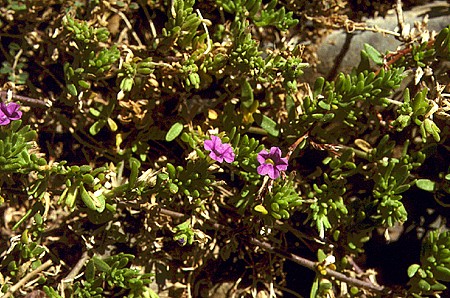
Synonymy
*Calibrachoa parviflora (A. L. Juss.) D'Arcy, Phytologia 67(6): 464-465 (1989)
Petunia parviflora A. L. Juss., Ann. Mus. Paris 2: 216; t. 17 fig. 1 (1803).
T: Commerson s.n., 1767, Argentina (P), n.v.
Description
Annual or short lived perennial mat-forming herbs to 15 cm high, rooting at the nodes, densely minutely glandular pubescent, viscid.
Leaves oblong-linear to spathulate, 5–12 mm long, sessile, somewhat succulent, malodorous.
Pedicels 1–2 mm long. Calyx 5–6 mm long; lobes linear-spathulate, intersepalar membranes distinct. Corolla funnel-shaped, slightly exceeding calyx lobes c. 5–9 mm long, pinkish to bluish-purple; limb shallowly lobed. Stamens attached to corolla tube, filaments 3–4 mm long; anthers 0.5 mm long. Style 3–4 mm long, bent at apex.
Capsule 3–5 mm long, much exceeded by calyx lobes. Seeds subglabrous, 0.3 mm wide, purple-brown.
Distribution and ecology
A weed, native of tropical America, only recorded from N.S.W. where common in low lying areas along the Peel and Namoi Rivers and around Newcastle. There are also records from around Boggabri.
Heyligers (2008) has documented the occurrence in the Newcastle area and suggests that it was introduced from ballast. The earliest record from NSW was in 1910 from Stockton Beach. Britton & Brown (1913) also suggested that ballast was the source of this plant in the United States.
The species is now extremely popular in cultivation since breeding from selected wild populations from South America has produced a large range of colours and the plants are perennial. For images of Calibrachoa hybrids used in gardening see the PlantFinder site of the Missouri Botanical Garden at www.mobot.org/gardeninghelp/plantfinder/Plant.asp?code=A119
References: Britton N.L. & Brown, A. (1913). An illustrated flora of the northern
Common name
In American this species is commonly referred to as Sea-side petunia. In Australia cultivars of Calibrachoa are referred to as Perennial Petunia or Million Bells amongst others.
Selected specimens
N.S.W.: Boggabri district, Apr. 1948, J. O’Reilly (NSW). Peel River, Somerton, Nov. 1994, J. R. Hosking 1046 & G.A. Wicks (NSW).
Derivation of epithet
From parvus, latin for small and florus, Latin for flower
Images and information on web
Further information on this species with links to more information can be found on the USDA site and further images at the CalPhotos site.
Images and information should be searched for under both Calibrachoa parviflora and Petunia parviflora, since both names are used for this species.



